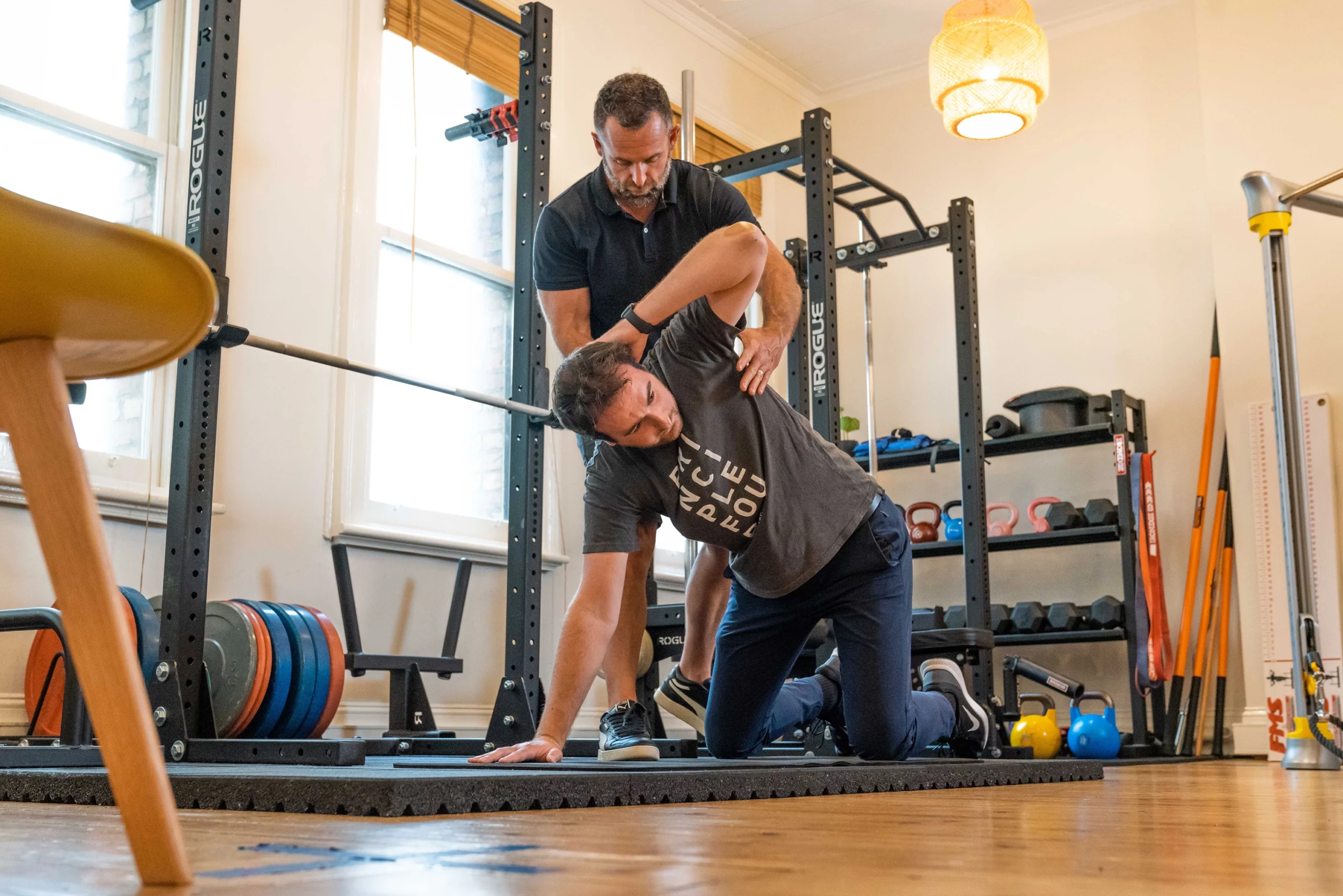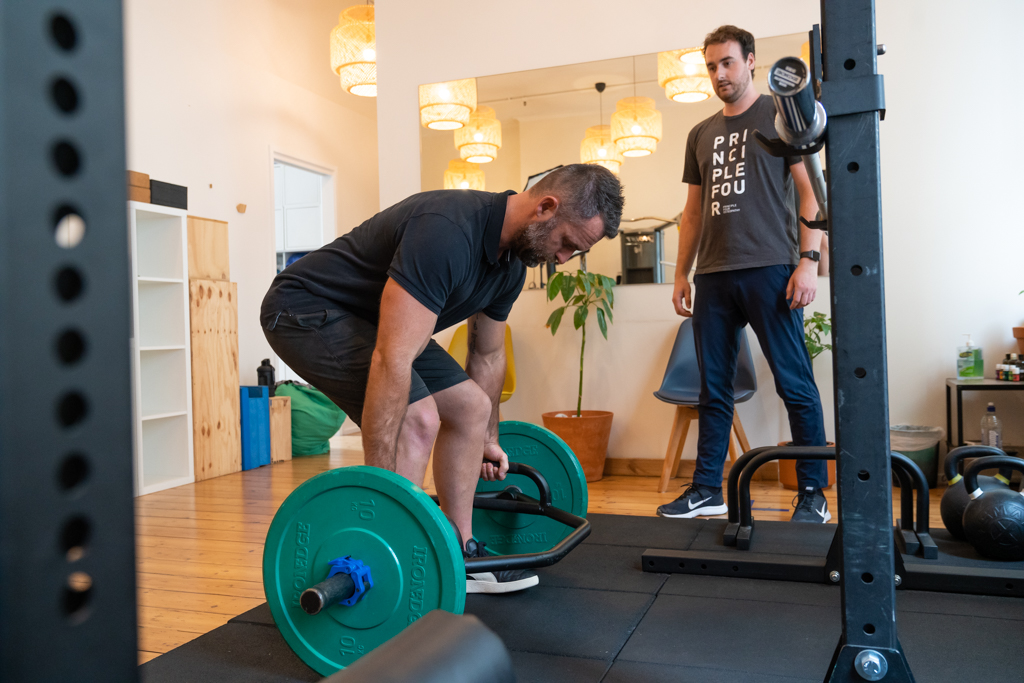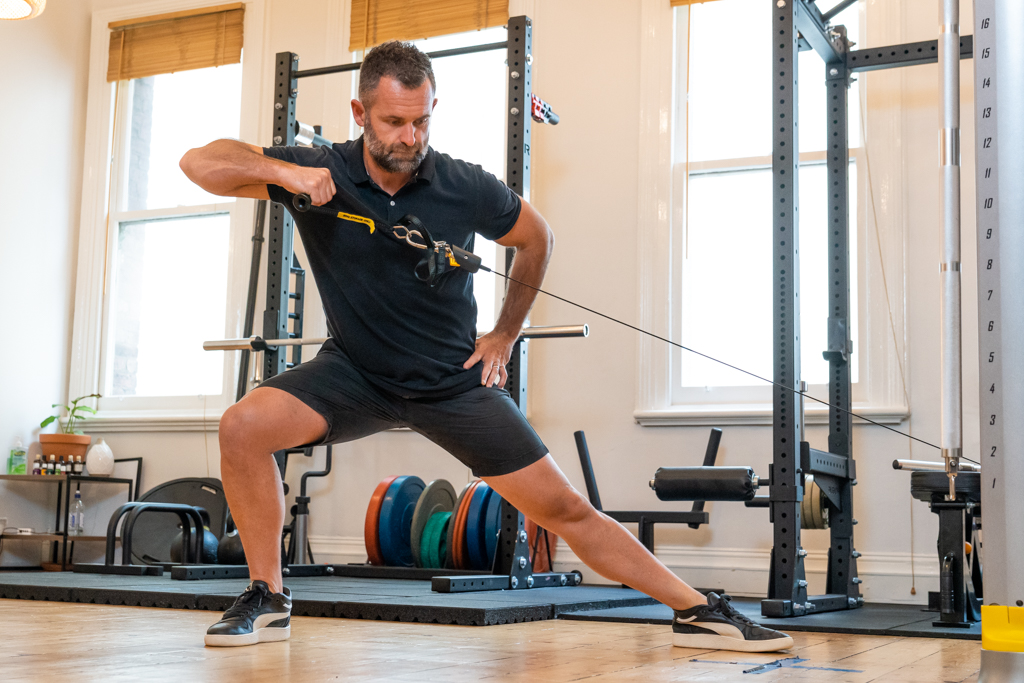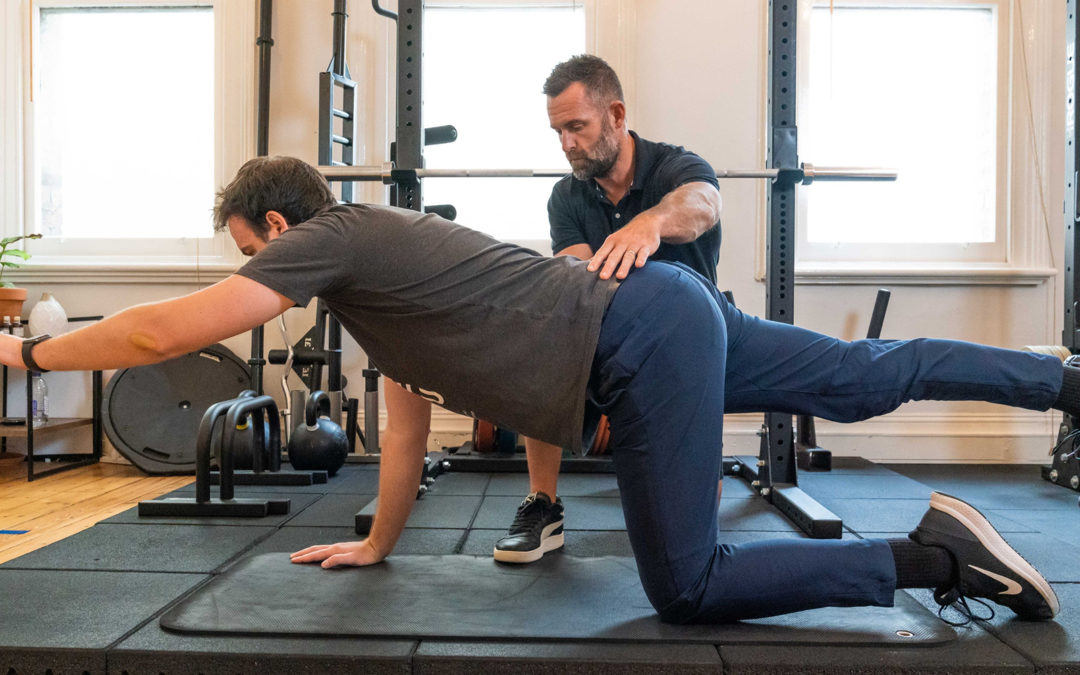Training around an injury
At Principle Four Osteopathy we have many clients presenting to the clinic with variety of musculoskeletal complaints who love and are passionate about keeping active. Our clients are typically keen to stay active for a variety of reasons.
Some of these include:
-
Maintaining Fitness Levels: By adapting your training to work around an injury, you can continue to engage in physical activity and maintain your overall fitness levels. Regular exercise promotes cardiovascular health, muscular strength, flexibility, and endurance. By staying active, you can prevent deconditioning and maintain your progress even during the recovery phase.
- Mental Well-being: Exercise is known to have positive effects on mental health, including reducing stress, anxiety, and depression. Continuing to exercise while injured can help you maintain a sense of routine, release endorphins, and provide a positive outlet for stress relief. It can also enhance your mood and overall well-being during the recovery process.
-
Promoting Healing and Rehabilitation: In many cases, moderate exercise and specific rehabilitation exercises can facilitate the healing process. Controlled movements and targeted exercises can improve blood circulation, reduce inflammation, and promote tissue regeneration. Working with a qualified healthcare professional or physical therapist can help you design a safe and effective exercise plan tailored to your injury and recovery needs.
-
Preventing Muscle Atrophy and Joint Stiffness: When an injury immobilizes a specific body part, muscle atrophy (loss of muscle mass) and joint stiffness can occur. By engaging in exercises that do not aggravate the injury, you can help maintain muscle strength and flexibility around the affected area. This can expedite the recovery process and prevent secondary complications.
-
Psychological Benefits: Continuing to exercise, even with an injury, can provide a sense of control, accomplishment, and empowerment. It allows you to focus on what you can do instead of what you can’t, fostering a positive mindset and enhancing self-esteem. It also helps maintain a connection to your fitness goals and can provide motivation for a smooth transition back to your regular exercise routine after recovery.
However, it is important to note that training around an injury should be approached cautiously and under the guidance of a healthcare professional. They can provide guidance on appropriate modifications, intensity levels, and exercises that minimize the risk of exacerbating the injury.
The initial consult
Clarifying what your injury is, how to manage it and to work around it with your training
If you have recently suffered an injury and are looking for advice on how to best manage this complaint whilst working around an injury, then we will sit down with you to discuss the following:
- Your current injury signs and symptoms
- Discuss the mechanism of your injury
- Discuss any past medical history that relates to this injury as well as other musculoskeletal issues
- Discuss more broadly your general medical history as this can sometimes impact on your current concerns
- Discuss what your current goals are in relation to your injury as well as more broadly with keeping active
- Discuss your current sporting, work or training requirements that may impact on your current injury
Following our case history we will then move into the assessment phase of the consult. Our assessment will include the following:
- Take you through a range of local and more global assessments that will include active movement, passive movement, active resisted muscular loading and any relevant orthopaedic assessments
- Take you through more task specific movements or functional movements that you currently need to perform or are having specific issues with
Our goal will be to provide you with a working diagnosis of your current injury and then provide you with a range of treatment and management options. This may include manual therapy, ergonomic advice, activity or task specific modifications and referral for further investigations or assistance with pain management or diagnosis if required.
We will also identify what we need to work on with regards to your specific complaint from a flexibility/mobility and strengthening point of view as well as identify and work with you to plan how we can continue training around your complaint.

Addressing flexibility and mobility
Addressing both local and areas above and below the area of concern
Addressing flexibility and mobility in relation to a specific musculoskeletal complaint, as well as the regions around the injury, is crucial for both health and performance. Here’s why it’s important:
-
Promotes Healing and Recovery: Flexibility and mobility exercises help improve blood circulation, which can aid in delivering nutrients and oxygen to the injured area, facilitating the healing process. By addressing the surrounding regions, you can also prevent compensatory movements and imbalances that may hinder the healing of the injured area.
-
Restores Range of Motion: Injuries and musculoskeletal complaints can lead to limited range of motion. By focusing on flexibility and mobility exercises, you can regain or maintain the full range of motion in the affected area. This is vital for functional movements, preventing stiffness, and allowing you to return to your regular activities or sports.
-
Reduces the Risk of Future Injuries: Musculoskeletal complaints can often be caused or exacerbated by imbalances, weak muscles, or poor movement patterns. Addressing flexibility and mobility in relation to the injury helps identify and correct these issues, reducing the risk of re-injury or developing new injuries. By improving overall joint mobility and flexibility, you enhance the body’s ability to handle stress and movement demands.
-
Enhances Performance: Flexibility and mobility are essential for optimal performance in various physical activities and sports. By targeting the regions around the injury, you can improve overall movement mechanics, posture, and stability. This leads to better body control, improved power output, and decreased risk of performance-limiting factors.
-
Improves Muscle Function and Strength: Flexibility and mobility exercises not only increase joint range of motion but also improve muscle elasticity and function. By addressing the muscles around the injury, you can enhance their flexibility, coordination, and strength, promoting efficient movement patterns and reducing strain on the injured area.
-
Supports Long-Term Joint Health: Maintaining good flexibility and mobility helps promote joint health and prevent age-related decline. By addressing flexibility and mobility in relation to an injury, you establish a foundation for continued joint health and longevity, reducing the risk of future musculoskeletal issues.

Strength, Endurance and Power
Addressing both local areas and other regions of the body
Maintaining strength, endurance, and power in the areas above and below an injured area of the body is important for several reasons:
-
Balanced Muscle Development: When an injury occurs, the affected area often undergoes a period of reduced or limited activity. This can result in muscle imbalances, with the muscles above and below the injury becoming weaker or deconditioned. By focusing on maintaining strength, endurance, and power in these areas, you can help restore balance and prevent further compensatory movement patterns or imbalances.
-
Joint Stability and Support: Strong muscles above and below an injured area provide important support and stability to the affected joint or body part. This can help alleviate stress on the injured area and aid in its recovery. By maintaining strength, endurance, and power in these regions, you enhance joint stability, reduce the risk of reinjury, and promote overall functional movement.
-
Efficient Movement Patterns: Strength, endurance, and power in the areas surrounding an injury contribute to overall movement efficiency and coordination. By ensuring that the muscles above and below the injured area remain strong and functional, you can maintain proper movement mechanics and prevent compensation patterns that may lead to further issues or decreased performance.
-
Injury Prevention: Strengthening the areas above and below an injured area can help prevent future injuries. Strong muscles provide better support, absorb shock more effectively, and help distribute forces during physical activities. By addressing strength, endurance, and power in these regions, you improve the overall resilience of the musculoskeletal system and reduce the risk of future injuries.
-
Return to Pre-Injury Performance: Rehabilitation following an injury involves gradual progression and the restoration of strength, endurance, and power. By focusing on maintaining these attributes in the areas above and below the injured site, you can enhance the recovery process and improve your ability to return to your pre-injury level of performance.
-
Overall Fitness and Performance: Strengthening the areas above and below an injured area contributes to overall physical fitness and performance. It allows you to maintain or improve your overall strength, endurance, and power, even while the injured area is healing. This is particularly important for athletes or individuals who engage in demanding physical activities that require full-body integration and coordination.
It is important to work with a healthcare professional or qualified exercise specialist to develop an appropriate exercise program that targets the areas above and below the injured site. They can provide guidance on exercise selection, progression, and intensity to ensure safety, promote healing, and optimize overall performance.
Looking at cross training options
Taking a look at other training approaches in the interim
Cross-training is highly beneficial when you have a musculoskeletal injury. Here’s why it is important and the benefits it offers:
-
Injury Recovery and Rehabilitation: Cross-training allows you to continue exercising while reducing the strain on the injured area. By engaging in alternative activities that don’t aggravate the injury, you can maintain cardiovascular fitness, muscular strength, and overall conditioning. This promotes blood circulation, which aids in the healing process and helps prevent deconditioning.
-
Reduced Risk of Overuse Injuries: Focusing solely on one type of activity or exercise can increase the risk of overuse injuries. Cross-training involves participating in a variety of activities that target different muscle groups and movement patterns. By diversifying your exercise routine, you distribute the stress on your body more evenly and reduce the likelihood of developing new injuries or exacerbating existing ones.
-
Improved Muscular Balance and Function: Cross-training helps address muscle imbalances that can contribute to the development of injuries. By engaging in different activities, you work various muscle groups, promoting balanced muscle development and enhancing overall functional movement patterns. This can improve joint stability, coordination, and reduce the risk of compensatory movements.
-
Enhanced Overall Fitness: Cross-training allows you to work on different aspects of fitness, such as cardiovascular endurance, strength, flexibility, and agility. By incorporating a variety of activities, you improve your overall fitness level and enhance your ability to perform a wide range of physical tasks.
-
Mental Stimulation and Motivation: Engaging in different activities keeps your exercise routine interesting and mentally stimulating. It can prevent boredom, help you stay motivated, and maintain a positive attitude during the recovery process. By exploring new activities, you may discover new interests and find enjoyment in different forms of exercise.
-
Long-Term Injury Prevention: Cross-training helps improve your body’s resilience by developing strength and flexibility in various muscle groups. This can help prevent future injuries by reducing the strain on specific areas and enhancing overall physical fitness. It also allows you to develop a more well-rounded and adaptable body that is better equipped to handle different movement demands and activities.
When cross-training with a musculoskeletal injury, it’s important to choose activities that do not exacerbate or further injure the affected area. Consult with a healthcare professional or qualified exercise specialist to develop a tailored cross-training program that suits your injury, abilities, and goals. They can guide you in selecting appropriate activities, monitoring your progress, and ensuring a safe and effective rehabilitation process.

Conclusion
Staying active and training around a specific musculoskeletal injury is important for several reasons:
- Maintains overall fitness and prevents deconditioning during the recovery process.
- Promotes circulation and aids in the healing of the injured area.
- Helps prevent muscle imbalances and compensatory movements.
- Reduces the risk of developing new injuries or exacerbating existing ones.
- Improves joint stability, flexibility, and overall functional movement patterns.
- Supports mental well-being and motivation during the recovery journey.
- Enhances long-term injury prevention by developing a resilient and adaptable body.
By staying active and training around an injury, you can minimize setbacks, maintain physical and mental well-being, and facilitate a smoother transition back to regular activity levels after recovery.
FAQs About The Topic
Which consultation should I book?
If you have recently suffered from an injury and require assistance on how to best manage that injury, whilst also training around that particular injury, then book an osteopathic consultation with one of our osteopaths at Principle Four Osteopathy. If you are an existing client at Principle Four Osteopathy, book a long osteopathic consultation (60 minutes) so that we can spend the necessary time to evaluate your complaint whilst also providing appropriate treatment and management advice.
What does a consultation cost?
The cost of a consultation at Principle Four Osteopathy ranges from $130 – 140 for an initial or long return consultation. Please check out our practitioners here.
What do I need to bring with me to a consult?
You do not need to bring anything specific with you. We have a range of shorts and singlets that you can wear should we need to head to the gym in our clinic or we have gowns and shorts to wear in the treatment if needed. Should you wish to bring your own training clothes and additional information that will be helpful for us i.e. medical imaging reports etc, please feel free to email these to info@principle4.com or bring them with you.
How do I book an appointment?
The easiest way to book an appointment is online via our online booking platform. Click here.
What if I have some questions that I would like to speak to you about before booking in?
We understand that you may have questions that you would like ask before booking in. Please email info@principle4.com with your name, email and best contact number and one of our osteopaths will call you to discuss any questions you might have prior to booking in.
About The Author
Heath Williams

Heath graduated from Victoria University in 2003 with a bachelor clinical science and master’s in health science (osteopathy). Since then he has had a varied work career in the health sector.
He lectured at the British School Osteopathy, London School Osteopathy, Victoria University and Southern Cross University within the osteopathy departments. Teaching roles have included 9 years teaching exercise rehabilitation, 8 years ergonomics and 16 years clinical education.
In addition to this Heath also teaches post graduate training to health professionals in office and vehicle ergonomics, manual handling training and strength and conditioning.
Heath has worked extensively in the occupational health and safety industry, firstly with Health Response UK in London and now with Corporate Work Health Australia.

